Arduino PRO Portenta H7 board and carrier

Production ready certified hardware. Designed for demanding industrial control, AI edge processing, and robotics applications
Arduino®
Saturday 14 November 2020
Portenta H7
With two asymmetric cores to simultaneously run high level code such as protocol stacks, machine learning or even interpreted languages like MicroPython or JavaScript along with low-level real time tasks
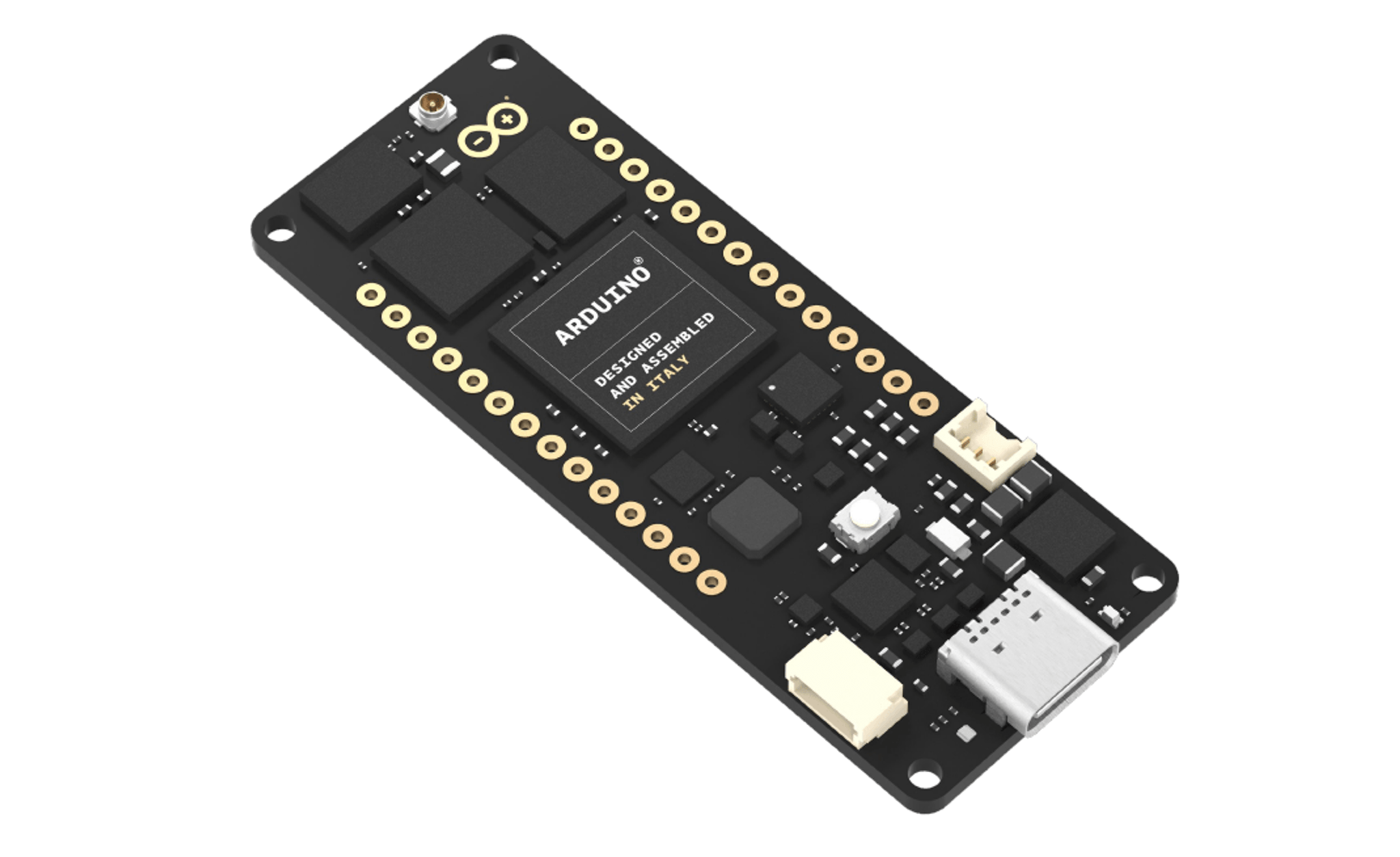
Portenta H7 board - Arduino®
A new board designed for high performance, meet Portenta H7
Program it with high-level languages and AI while performing low-latency operations on its customizable hardware
The Portenta H7 is open-source hardware! You can study how the board works using the following files: Schematics
Portenta H7 simultaneously runs high level code along with real time tasks
H7’s main processor is the dual core STM32H747 including a Cortex® M7 running at 480 MHz and a Cortex® M4 running at 240 MHz. The two cores communicate via a Remote Procedure Call mechanism that allows calling functions on the other processor seamlessly.
Both processors share all the in-chip peripherals and can run:
- Arduino sketches on top of the Arm® Mbed™ OS
- Native Mbed™ applications
- MicroPython / JavaScript via an interpreter
- TensorFlow™ Lite
The onboard wireless module allows to simultaneously manage WiFi and Bluetooth® connectivity. The WiFi interface can be operated as an Access Point, as a Station or as a dual mode simultaneous AP/STA and can handle up to 65 Mbps transfer rate. Bluetooth® interface supports Bluetooth Classic and BLE.
The Portenta H7 follows the Arduino MKR form factor, but enhanced with the Portenta family 80 pin high-density connector. Learn more about the board’s pinout by reading the board’s pinout documentation.
Use Portenta when performance is key
- High-end industrial machinery
- Laboratory equipment
- Computer vision
- PLCs
- Industry-ready user interfaces
- Robotics controller
- Mission-critical devices
- Dedicated stationary computer
- High-speed booting computation (ms)
A new standard for pinouts
The Portenta family adds two 80 pin high density connectors at the bottom of the board. This ensures scalability for a wide range of applications by simply upgrading your Portenta board to the one suiting your needs.
Multiple options in one board
By default the Arduino Portenta H7 comes with:
- STM32H747 dual-core processor with graphics engine
- 8MB SDRAM
- 16MB NOR Flash
- 10/100 Ethernet Phy
- USB HS
- NXP SE050C2 Crypto
- WiFi/BT Module
- UFL Connector (Antenna)
- DisplayPort over USB-C
Tailor the hardware to your needs
If you need more memory, Portenta H7 can host up to 64 MByte of SDRAM, and 128 MByte of QSPI Flash. Comes with an external UFL connector for adding a high-gain antenna to the board. Decide between crypto-chips from Microchip® and NXP.
Portenta H7 tech specs
| MAIN PROCESSOR | STM32H747XI dual Cortex®-M7+M4 32bit low power Arm® MCU |
| SDRAM | 8-64 MByte option |
| QSPI FLASH | 2-128 MByte option |
| ETHERNET | 10/100 Phy option |
| WIRELESS | BT5.0 + WiFi 802.11 b/g/n 65Mbps option |
| CRYPTO CHIP | ECC608 or SE050C2 (Common Criteria EAL 6+) option |
| DISPLAY CONNECTOR | MIPI DSI host & MIPI D-PHY to interface with low-pin count large displays |
| GPU | Chrom-ART graphical hardware Accelerator™ |
| TIMERS | 22x timers and watchdogs |
| UART | 4x ports (2 with flow control) |
| SD CARD | Interface for SD Card connector (through expansion port only) |
| OPERATIONAL TEMPERATURE | -40 °C to +85 °C |
| POWER | Through USB-C connector or LiPo battery (integrated charger) |
| CURRENT CONSUMPTION | 2.95 μA in Standby mode (Backup SRAM OFF, RTC/LSE ON) |
| USB-C | Host / Device, DisplayPort out, High / Full Speed, Power delivery |
| MKR HEADERS | Use any of the existing industrial MKR shields on it |
| HIGH DENSITY CONNECTORS | Two 80 pin connectors will expose all of the board’s peripherals to other devices |
| ESLOV CONNECTOR | Arduino’s open connector standard for self-identifiable hardware |
| CAMERA INTERFACE | 8-bit, up to 80 MHz |
| ADC | 3× ADCs with 16-bit max. resolution (up to 36 channels, up to 3.6 MSPS) |
| DAC | 2× 12-bit DAC (1 MHz) |
Portenta Carrier
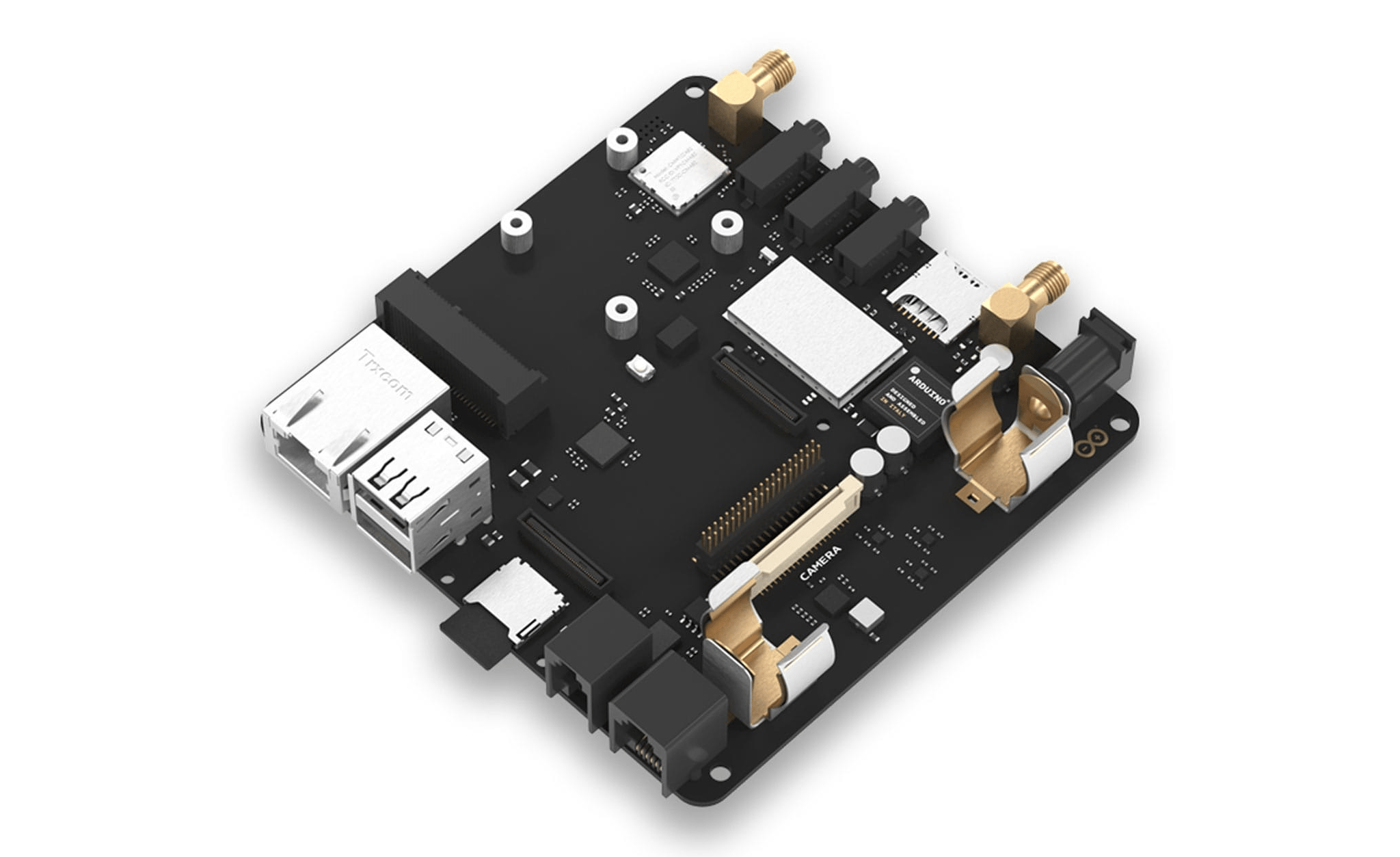
Portenta Carrier - Arduino®
Add extra capabilities to your H7 board with the Portenta Carrier
Expose all of the Portenta H7’s peripherals and physical connectors
Enhance the basic capabilities of your Arduino Portenta H7
The Portenta Carrier exposes all of the extra capabilities of the processor on your microcontroller board through connectors and peripherals that do not physically fit on it. There are connectors for USB, RJ-45, CAN bus, audio in and out lines, camera, DisplayPort, etc.
This design expands the default communication ports of Portenta boards to other wired and wireless protocols. Gigabit Ethernet will let you transform your board into a dedicated access point, a network drive, or even a serial-to-ethernet bridge. Adding a SIM card to the board makes it possible to connect to NBIoT or GPRS networks. Thanks to its LoRa® connectivity you can design your own gateway to host your wireless sensor network.
Adding an 8-bit camera sensor to the Portenta Carrier camera connector will help you implement any kind of computer vision application. And if the onboard computing power is not enough, you could enhance your board’s AI capabilities by adding state-of-the-art Machine Learning modules through the Carrier’s miniPCI connector (like Google’s Coral unit of computation).
Applications of the Portenta Carrier together with your Arduino Portenta H7
- Computing machines for industrial environments
- High-end portable dataloggers
- Gateways between M2M networks
- Upgrading machines running legacy wired protocols
- Distributed low-power computation
- Single-board full mechatronics controller
Portenta Carrier tech specs
| FORM FACTOR | eNUC form factor from SGET |
| ETHERNET | Gigabit Ethernet connector (RJ-45) |
| USB HUB | 2x female connectors |
| SD CARD | microSD connector |
| CELLULAR NETWORK | NBIoT / CatM1 / GPRS Modem & SIM card connector |
| LORA® | Murata CMWX1ZZABZ LoRa® module |
| POWER | Through external supply, or on-board battery connector |
| GPIO | General GPIO connector, 40 pins |
| VIDEO INPUT | 8-bit LVTTL/2 lane MIPI |
| ANTENNAS | 2x antenna connectors |
| AUDIO | 3x audio-jacks for in- or output of analogue sound |
| EXTERNAL MODULES | Via miniPCIe connector |
| CAN BUS | Via RJ-9 connector |
| RS232 / 422 / 485 | Via RJ-11 connector |
Portenta Vision Shield
The Portentia Vision Shield is designed to extend the Portenta H7’s capabilities into computer vision and voice applications, packing an ultra-low-power Himax camera module — which is capable of detecting motion autonomously, only waking the Portenta board when necessary as a means of reducing power draw still further — and two omnidirectional MP34DT06JTR microphones configured as a beam-forming array.
Audio and vision data captured by the Shield’s sensors can be stored locally on a microSD card, transmitted via the Portenta’s own Wi-Fi or Bluetooth Low Energy radios, or via a wired connection using the Shield’s Ethernet port. A second variant will add the option of LoRa wireless connectivity before the end of the year, though is not launching alongside the Ethernet version.
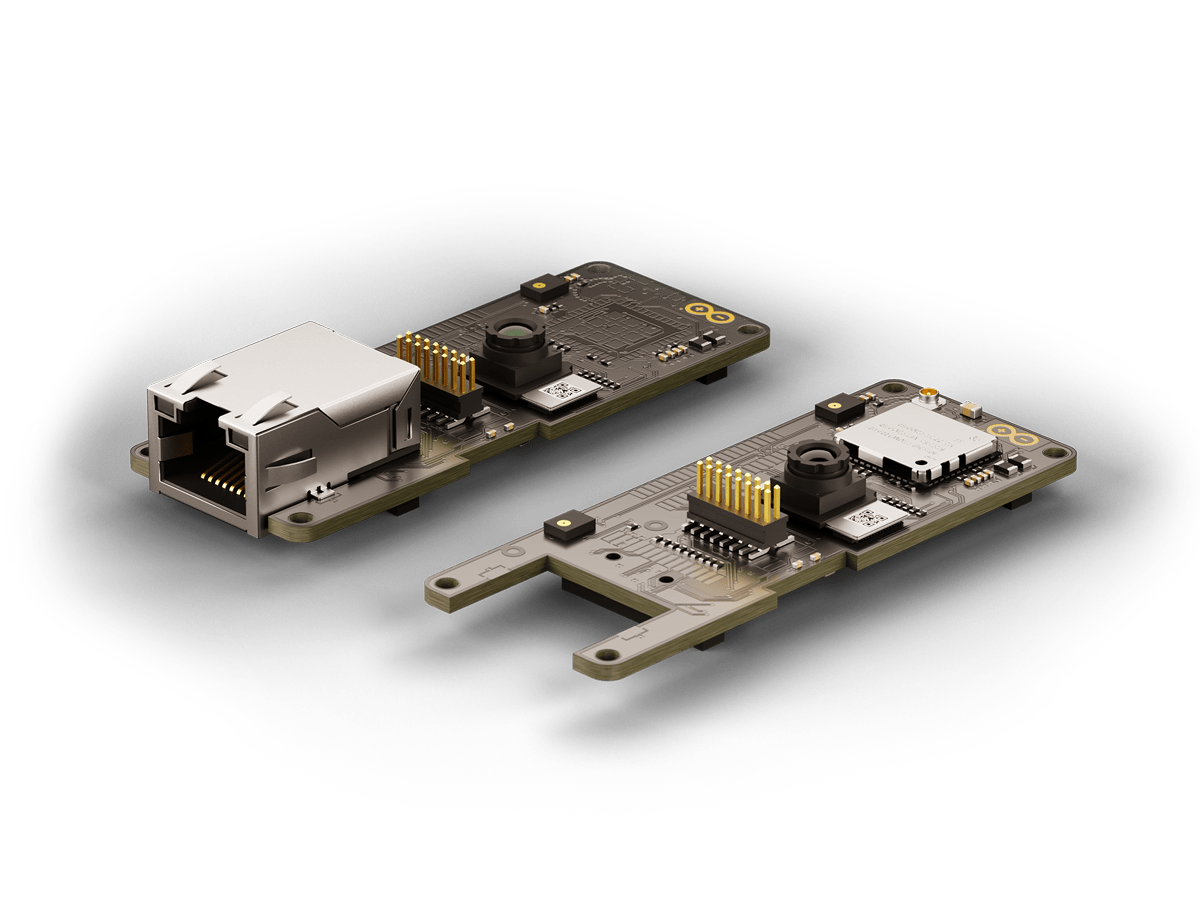
Portenta Vision Shield - Arduino®
The Vision shield comes with a 324x324 pixels camera module which contains an Ultra Low Power Image Sensor designed for Always-on vision devices and applications. The High sensitivity image sensors can capture gestures, ambient light, proximity sensing, and object identification.
The two omnidirectional built in digital-microphones allow you to capture sounds to the videos that can be stored on a MicroSD Card.
Transfer data either through Ethernet or LoRa® modules. Using OpenMV, any Professionals, Researchers and Developers can develop low cost Python powered camera vision and audio applications.
And compatible with the Arduino Portenta H7.
The Arduino Portenta Vision Shield with Ethernet connectivity is available from the Arduino Store priced at €41; the LoRa variant will follow later this year.
Portenta Vision Shield tech specs
| CAMERA | Himax HM-01B0 camera module |
| RESOLUTION | 320 x 320 active pixel resolution with support for QVGA |
| IMAGE SENSOR | High sensitivity 3.6μ BrightSenseTM pixel technology |
| MICROPHONES | Two MP34DT06JTR microphones |
| CONNECTIVITY | Ethernet or LoRa® |
| INTERFACES | JTAG |
| DIMENSION | 66*25mm |
Portenta Vision Shield software
For the software side, Arduino has partnered with OpenMV to add full Portenta and Vision Shield support to the OpenMV IDE. All Portenta users can download the OpenMV IDE v2.6.4 or higher to receive the support, with Arduino providing example sketches demonstrating the use of the Vision Shield.
Detect Gestures. Identify Objects. See things.
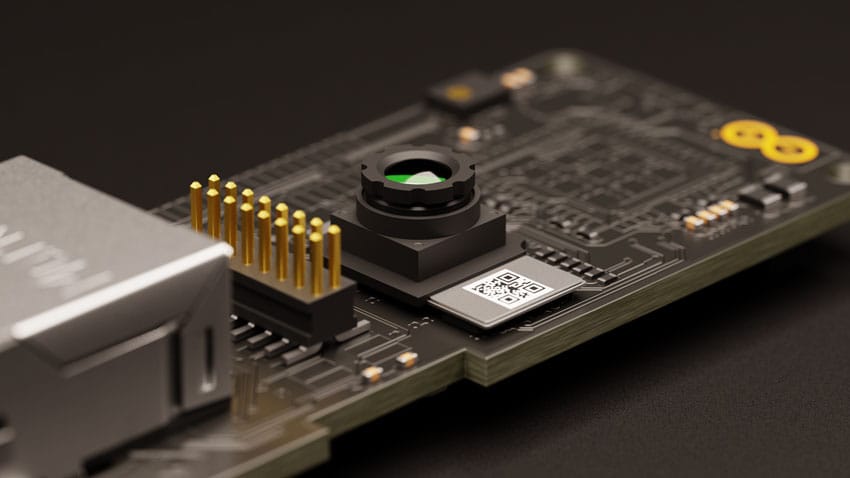
Portenta Vision Shield : Always-on machine vision with the ultra-low-power Himax camera - Arduino®
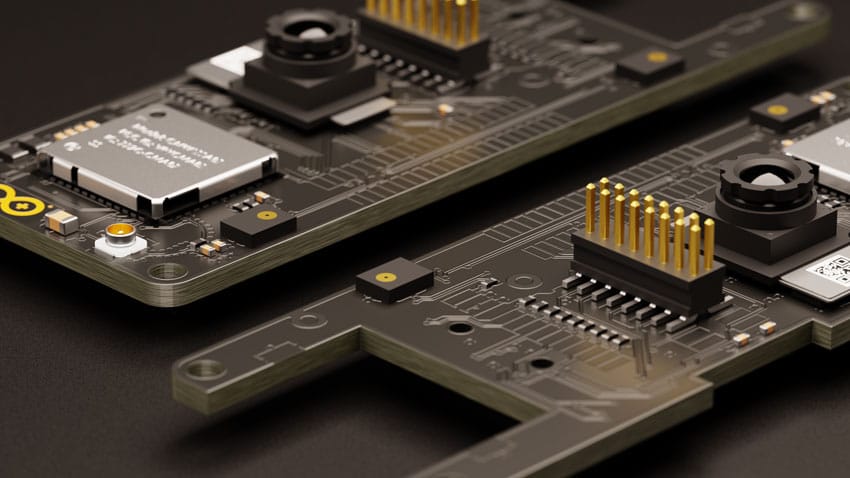
Portenta Vision Shield : Two beamforming microphones for voice/audio recognition in noisy environments - Arduino®
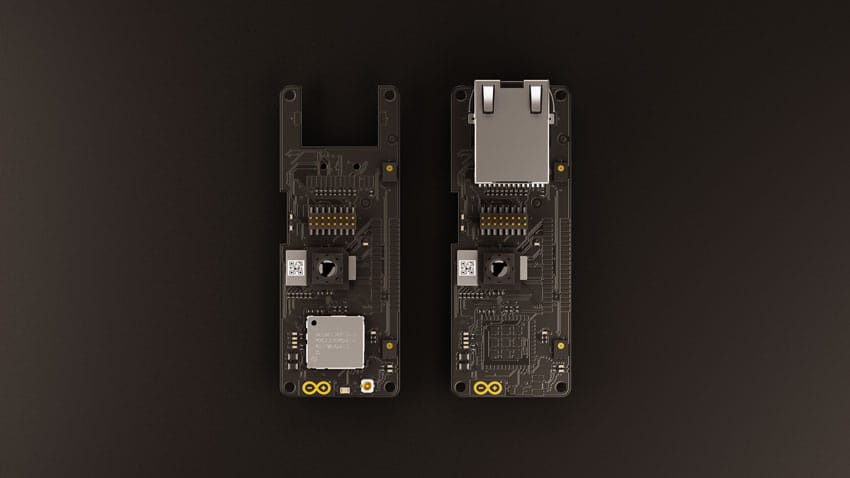
Portenta Vision Shield : Two versions: LoRa® (on the left) and Ethernet (on the right) - Arduino®
Tutorials
- Some Portenta H7 tutorials to set up and use the Portenta board.
- How to use the vision carrier board for Portenta to detect the presence and the position of objects in a camera image